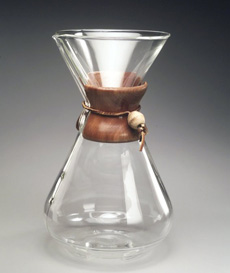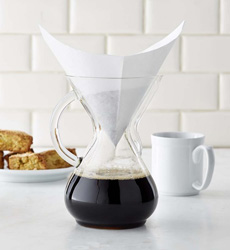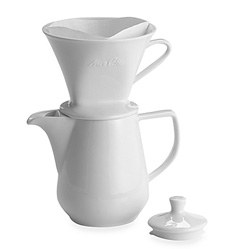TIP OF THE DAY: Pour-Over Coffee At Home
 [1] The 1941 Chemex design, represented at the Museum of Modern Art and other museums (this photo is from the Brooklyn Museum Of Art). It’s $49.99 at Bed, Bath & Beyond.
|
Waiting at a coffee bar recently, we overheard a customer watching her pour-over coffee dripping into the cup. She said to the barista: “I wish I could do this at home!”
You can, it’s easy, and a lot less expensive than the pour-over, which took four passes from the barista. In fact, in our youth… If they were lucky, they lived in a town with a specialty coffee and tea shop, with loose beans and packaged coffee from around the world. We were lucky: We lived in New York City, which had McNulty’s Tea & Coffee, established in 1895 and still located at 109 Christopher Street in the West Village (and still not open on Sundays). A visit to McNulty’s was a trip back to another age. Today, the journey is accented with modern coffee makers and gadgets that didn’t exist at the time. But the aroma is still the same: an exotic mingling of the many aromas of coffees and teas from around the world, kept in large glass canisters. There were burlap sacks of beans and chests of tea with stenciled markings from far away lands. The brass scale was also from the 19th century. Amid the tea and coffee was one ultra-modern brewing apparatus: the Chemex drip coffee maker. Pour over, also called manual drip brewing or the drip method, is a fashionable new term for an old, low-tech method of coffee brewing. Ground coffee is added to a ceramic or plastic cone that sits in a paper filter atop a glass carafe, ceramic pot, coffee cup or another receptacle. The Chemex system eliminates the need for a cone by creating a carafe with a narrow neck that holds the filter. The pour-over technique was invented by a German housewife, Melitta Benz, in 1908. Displeased with the grittiness and murkiness of coffee as it was then prepared, she devised a paper filter from a sheet of her son’s notebook paper, and set the filter into a brass cup into which she punched holes for the coffee to drip through. The commercial version was made in ceramic (today available in ceramic or plastic). As anyone who has used a Melitta drip brewer knows, it became a great success for its superior brew. Fast-forward a few decades, to inventor Peter Schlumbohm, a Ph.D. chemist who had immigrated to the U.S. from Germany. He developed and sold his patents focused on heating and cooling systems, the thermos bottle, and dry ice manufacturing among them. In 1941, he released the Chemex drip coffee system with the coffee filter placed in a glass carafe. Like the Melitta, the filter was filled with ground coffee and hot water, which drip-drip-dripped into the carafe. |
|
|
Like the Melitta, it wasn’t the fastest cup of coffee around, but people with palates applauded the superior flavor. If you liked good black coffee, drip coffee was the way to go. Its Bauhaus style design, elegant in thermal glass from Corning, received a big endorsement from the design community and was featured on the cover of the Museum of Modern Art’s “Useful Objects in Wartime” bulletin, making it “the official poster-child of [the] new emphasis on undecorated, functional simplicity [source]. It is included in the design collection of the Museum. |
||
|
The Next Revolution In Home Coffee Brewing In 1971, the first electric drip coffee maker to hit the consumer market, Mr. Coffee, revolutionized how many Americans brewed their coffee. Adios, percolator; bienvenidos, Mr. Coffee. Mr. Coffee engendered shelves full of electric drip brands, which remained paramount until the Keurig single-serve beverage brewing system and the proliferation of K-Cup options took hold. In 2002, some 10,000 units were sold to offices, replacing the Bunn system and the need to clean the coffee pots and drink coffee that had been sitting on the burner for too long. Consumers loved the Keurig system, and by 2006, Green Mountain Coffee Roasters had acquired a stake and signed up leading coffee brands for the K-Cups. Gosh, has it only been ten years? While the Melitta, Chemex, and other pour-over apparatuses remained a niche product, our first experience with the modern pour-over took place in 2006 in San Francisco, where the line of customers stretched around the block to get a cup from Blue Bottle Coffee. As our job is to know what’s new and wonderful in the world of food and drink, we waited for some 25 minutes. Sure, it was a good cup of coffee, but we didn’t do it again. And we didn’t have to: The trend proliferated, and soon there was enough drip coffee in our own neighborhood to eliminate the line wait. This brings us to the present: pour-overs at home. You can still buy a Melitta, and an improvement on it, the Pour-Over Coffee Maker with Water Tank Good Grips. The water stays hot in the mini-tank instead of in an open filter. All you need is to add ground coffee and hot water—no paper filter. The set (photo at right) is just $15.99 at Oxo.com Here are Blue Bottle’s drip coffee-making tips. |
 [4] It’s easy to make pour-over coffee at home with this $15.99 system from Oxo.
|
|
|
CHECK OUT WHAT’S HAPPENING ON OUR HOME PAGE, THENIBBLE.COM. |
||





